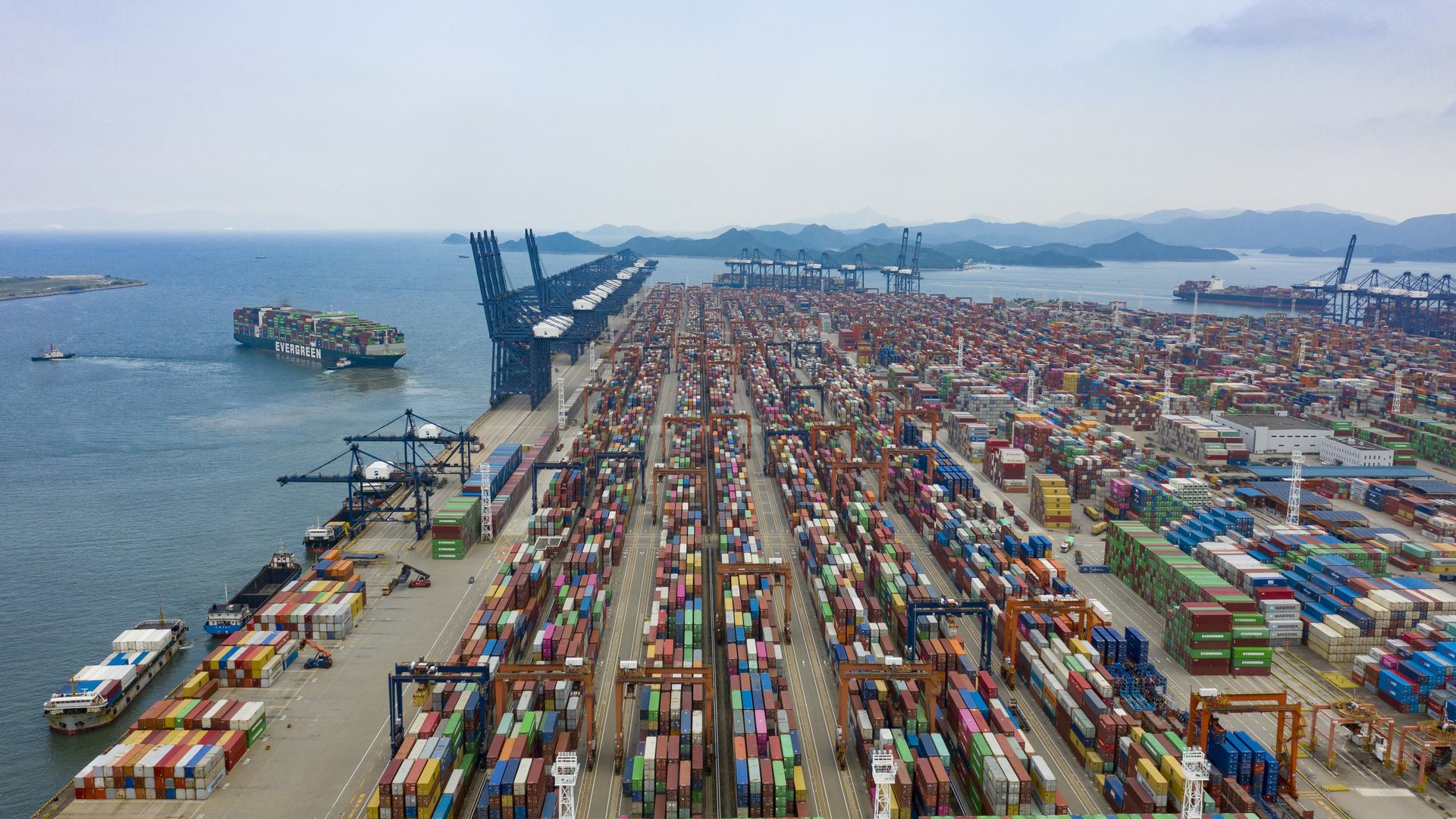| | | | | | | Presented By OurCrowd | | | | Axios Markets | | By Sam Ro ·Jul 07, 2021 | | Today's newsletter is 1,125 words, 4 minutes. 🔥 of the day: COOK, the ticker wood-fired grill maker Traeger Inc. wants to trade under when it goes public. | | | | | | 1 big thing: S&P 500 index funds balloon |  Data: S&P Dow Jones Indices; Chart: Axios Visuals Not all investors are trying to beat the market. According to S&P Dow Jones Indices, a record $5.4 trillion was parked in funds that passively track the S&P 500 at the end of 2020. Why it matters: There's plenty of data that shows most individual investors, and even professional money managers, can't beat the S&P 500 by actively managing their stock portfolios. By the numbers: At the end of 2008 during the financial crisis, there was just $915 billion worth of assets indexed to the S&P 500. The S&P closed at 903 that year. - As passive investing has become increasingly popular, assets indexed to the S&P nearly quintupled (+493%) to $5.4 trillion in 2020 as the index itself tripled (+316%) to 3,756.
- About 60% of large-cap equity fund managers underperformed the S&P 500 in 2020, according to a separate report from S&P Dow Jones Indices.
- This was the 11th straight year that a majority of these professional stock pickers lagged that benchmark.
Yes but: The active fund management business is alive and well. - Just over $8 trillion in actively managed funds use the S&P 500 as their benchmark for performance.
State of play: Even the pros who perform well in a given year are rarely able to stay on top. - S&P Dow Jones Indices found that of active large-cap equity fund managers in the top-performing half of their peer group in 2016, just 23% remained in the top in 2017. Only 10.5% repeated the feat three years in a row.
- And just 4.2% of active large-cap equity fund managers were able to stay in the top half for five consecutive years through 2020.
The bottom line: While historical odds favor investors who only aim to match the performance of the S&P 500, the allure of beating the market will continue to have investors wagering trillions. |     | | | | | | 2. Catch up quick | | Samsung Electronics says Q2 operating earnings probably jumped 53% amid soaring chip prices. (Reuters) Regulators in Beijing are considering closing a loophole that allows Chinese companies to list their shares overseas. (Bloomberg) Ever Given, the container ship that had blocked the Suez Canal, is due to resume its journey on Wednesday after reaching a settlement with the Suez Canal Authority. (Reuters) |     | | | | | | 3. Central banks speak up on inequality |  Data: BIS via Deutsche Bank; Chart: Axios Visuals The world's central banks are increasingly using their powerful platform to put a spotlight on inequality. Why it matters: Central banks control the money supply and interest rates, which affects financing costs for everyone. - Historically, the Federal Reserve — the central bank of the U.S. — had vague goals including achieving some generic "maximum level of employment."
- But last August, the Fed updated its statement on goals to clarify that this was "a broad-based and inclusive goal."
- "This change reflects our appreciation for the benefits of a strong labor market, particularly for many in low- and moderate-income communities," Fed chair Jerome Powell said at the time.
The big picture: The Fed's now-broader mandate, which includes achieving inflation that averages 2% over time, gives it more flexibility to keep monetary policy accommodative for longer. What they're saying: Deutsche Bank strategist Jim Reid says "recent years have seen central banks increasingly enter the debate on numerous other topics including fiscal policy, social justice, race, gender issues, climate change and inequality." - "These are all admirable and crucial topics to discuss and could help make the world a better place. However, it does show how central bank power and influence has changed and also how they seem to be giving governments cover to spend on these issues."
- Reid says this is a reason inflation could run a little hot for a while.
What to watch: In recent testimony to Congress, Powell emphasized how "joblessness continues to fall disproportionately on lower-wage workers in the service sector and on African Americans and Hispanics." |     | | | | | | A message from OurCrowd | | Meet the AI tech deployed by the world's largest food service company | | |  | | | | Invest in the tech transforming customer experience — at OurCrowd. Zippin combines advanced AI, computer vision and a sophisticated sensor system to enable contactless payments for the world's leading retailers. Explore Zippin's investment potential at OurCrowd. | | | | | | 4. Cargo glut loosens |  | | | Photo: Chen Changjun/VCG via Getty Images | | | | A key shipping port in Yantian, in southern China, is nearly back to full capacity after a recent COVID outbreak partially shut down operations, Axios' Hope King writes. Why it matters: Delays of up to 16 days were reported by shipping giant Maersk last month, threatening to slow down already logjammed global supply chains even further. - Waiting periods are now down to half a day on average, Maersk reports, with productivity at the port back to 85% of normal levels.
By the numbers: Yantian and neighboring ports are among the busiest in the world, but they're far from the only ports seeing delays. - Globally, schedule reliability remains below 40%, according to Denmark-based Sea Intelligence, compared to levels above 70%-80% in 2019.
- More than 400 ships traveling between Asia and the West Coast were late by more than two weeks during the first five months of this year. Compare that to 388 vessels in total that were late between 2012 and 2020.
What to watch: Retailers are concerned that existing backlogs may delay upcoming holiday season shipments. - The National Retail Federation urged President Biden in a letter last month to address supply chain issues as part of the administration's Build Back Better infrastructure plan.
|     | | | | | | 5. Jobs data at odds with jobs data |  The pace of hiring activity in services industries declined in June, according to the Institute for Supply Management. Why it matters: Labor supply constraints continue to limit the U.S. economy's ability to grow. - This was a reason the ISM services index fell to 60.1 in June from 64 in May, a sign that growth in the services sector is decelerating.
- The ISM services index is a measure of activity in nonmanufacturing businesses. Services account for 103.5 million jobs, or 71%, of the U.S. payrolls.
By the numbers: The ISM's services employment index — a subset of the overall index — fell to 49.3 in June from 55.3 in May, which means the amount of hiring went down. What they're saying: "Businesses haven't been able to staff according to the demand levels," Anthony Nieves, chair of the ISM's Services Business Survey Committee, told Axios. - "The labor markets are not there for some of these different services industries."
Yes, but: "That is at odds with the apparent message from the latest payroll figures, which suggested that employment growth is accelerating," Capital Economics' Michael Pearce observed. - Indeed, according to the June U.S. payrolls report, the services sector added 642,000 jobs in June, up from 497,000 added in May.
The bottom line: Expect mixed signals occasionally in short-term data, due to all sorts of data quality issues that have emerged during the pandemic. - But even amid this noise, the bigger themes seem to prevail.
- "The comments accompanying the survey make clear that labor shortages and supply shortages are still squeezing output," Pearce wrote.
|     | | | | | | A message from OurCrowd | | Meet the AI tech deployed by the world's largest food service company | | |  | | | | Combining advanced AI, computer vision and a sophisticated sensor system, Zippin helps optimize the checkout experience for consumers and retailers. Billion dollar retailers have deployed this tech. Now, you can invest. Zippin is transforming the trillion dollar retail industry. | | | | 📈 of the day: $32 billion, the total value of assets indexed to the Dow Jones Industrial Average. |  | | It'll help you deliver employee communications more effectively. | | | | | | Axios thanks our partners for supporting our newsletters. If you're interested in advertising, learn more here.
Sponsorship has no influence on editorial content. Axios, 3100 Clarendon Blvd, Suite 1300, Arlington VA 22201 | | | You received this email because you signed up for newsletters from Axios.
Change your preferences or unsubscribe here. | | | Was this email forwarded to you?
Sign up now to get Axios in your inbox. | | | | Follow Axios on social media:    | | | | | |








No comments:
Post a Comment